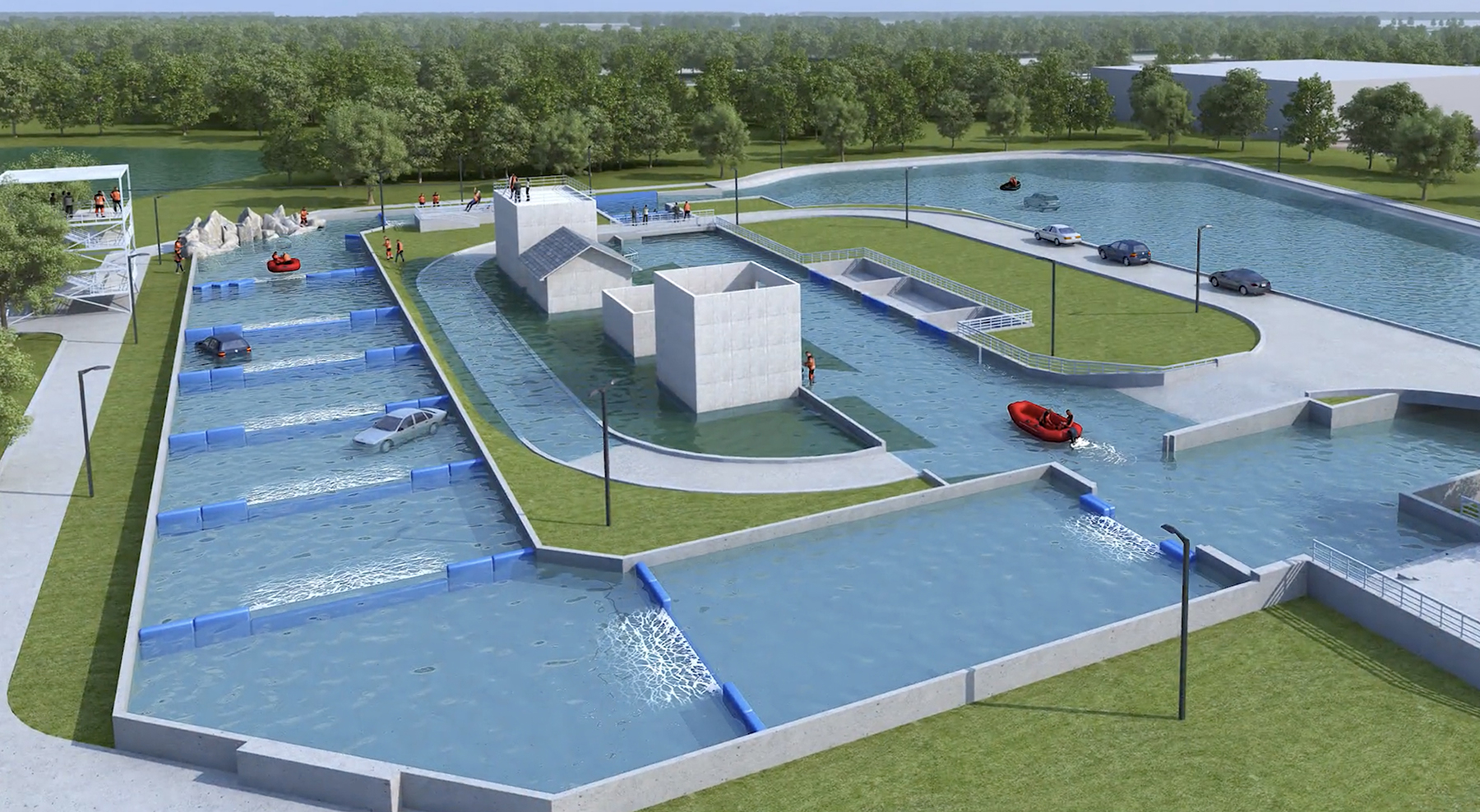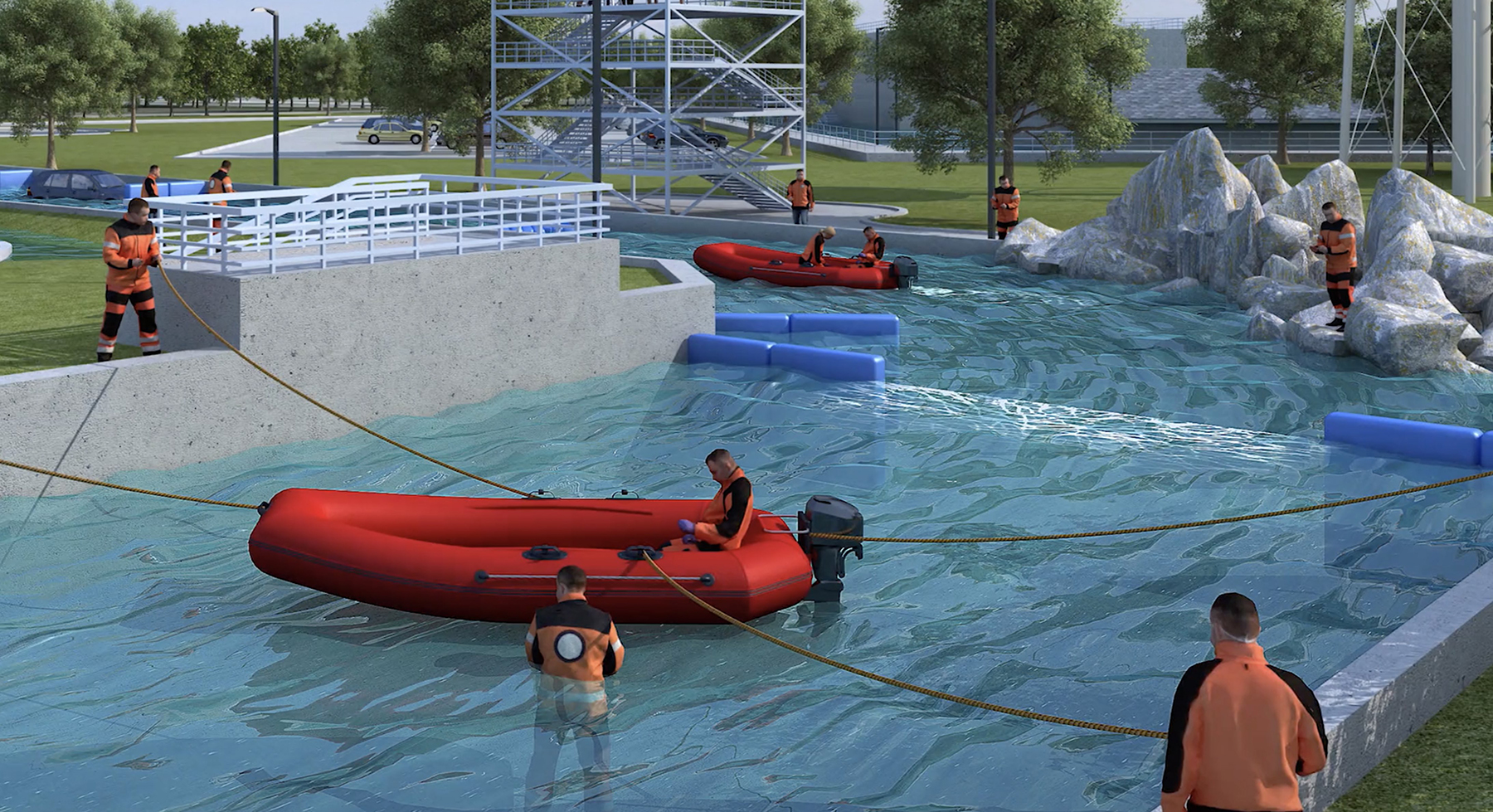By Jay Landers
For first responders in the United States, finding a place to conduct swift-water and urban-water rescue training in a realistic — but safe — setting can be a challenge. Other than the New York State Preparedness Training Center in Oriskany, New York, there are no urban-flood training centers in the country. Natural waterways, of course, are available for this purpose, but they present various risks and have certain limitations. Channel configurations and flow rates, for example, typically cannot be modified easily to accommodate the needs and ensure the safety of those undergoing what is inherently dangerous training.

To overcome such challenges, Houston Community College plans to construct a facility that is specially designed to meet the needs of first responders looking to conduct swift-water rescue and other water-related training exercises.
To be known as the Regional Response Operation Center, the $25 million, 75,000 sq ft facility will include multiple features intended to mimic various training scenarios. Among the features are a swift-water channel, a low-head dam, an area that approximates flooded streets and buildings, and a 25-acre pond for training associated with diving, powerboat operations, and flat-water rescues.
The RROC will be the “world’s most advanced urban-flood simulator solely dedicated to training fire, law enforcement, and (emergency medical service) responders on the technical skills necessary to perform life-saving water rescues,” according to a July 26 news release from S2O Design and Engineering, which is responsible for designing the project’s water features. The firm specializes in designing in-stream and recirculating whitewater parks.
Swift water and its dangers
“Swift-water rescue training is dangerous,” says Scott Shipley, P.E., the president of S2O and a former Olympian and World Cup kayak champion. “You’ve got ropes. You’ve got people. You’ve got vehicles. It’s all in whitewater and can wash away. People can drown. You can get sucked under a vehicle and drown. There’s a lot of things there that have a lot of risk.”
Designed with such risks in mind, the RROC will include a 350 cfs pump station that can be turned off instantly in the event that something untoward happens during a training exercise. To this end, every light pole in the facility will have a button that can be used to shut down the pump station if necessary. In such an event, “the water immediately starts to recede,” Shipley says. “Whatever the scenario is, you’re in rescue mode just with the hit of a button.”
A 39 ft wide channel will facilitate multiple swift-water training scenarios, including rescues involving boats, high ropes, bridges, and immersed vehicles. A “rocky gorge area” will simulate challenging real-world conditions in which access is difficult. Meanwhile, a movable obstacle system will be used to create whitewater conditions in the center of the channel while providing eddy areas on the sides where participants can gather while not actively involved in exercises.

Originally designed for whitewater competition, the movable obstacle system “gives us this tremendous flexibility to adapt the course to different scenarios with a wrench, as opposed to shifting concrete and moving rocks in a traditional channel,” Shipley says. The system also may be used to hold in place vehicles that are part of training exercises.
Having a water depth of about 6 ft, the low-head dam will generate the dangerous hydraulic condition known as a “reverse roller,” Shipley says. A reverse roller is formed by a high tailwater that results in a submerged hydraulic jump, or sudden rise in the water level, and involves a recirculating flow pattern that can trap victims at the dam’s base. These conditions are so dangerous that such dams are sometimes referred to as “drowning machines.”
The water levels at the low-head dam will be “deep enough that you can really feel the power of the hydraulics spinning you around and holding you underwater,” Shipley says. “But when you get into trouble, you can actually push off the bottom, get a breath, and request help. In that sense, it’s a pretty good design that allows for realistic training scenarios but doesn’t put people in this uncomfortable position.”
Flooding on Main Street
Although 80% of water rescues involve vehicles in swift water, that scenario is not representative of the conditions that occur during massive flood events, when “acres and acres of neighborhoods” are under water and emergency personnel must travel house to house in search of those in need of rescue, Shipley says.
To simulate these sorts of conditions, the facility will include a “Main Street” urban-flood simulator feature consisting of a two-story residential building, a residential building with a pitched roof, a high-ropes tower, and a mock two-story care facility that has a flat roof connecting to the high-ropes tower. To ensure realistic conditions, the feature will include narrowed street intersections, speed bumps, and raised crosswalks.
Flood conditions along the Main Street feature can take the form of sheet flow or water that reaches depths of up to 6 ft in some locations. Among the hazards that trainees will have to contend with are “sucking” maintenance holes that can trap a person with the strength of their hydraulic inflows, Shipley says. “We want to train people to identify those.”
To further simulate search-and-rescue operations in an urban area, the facility will include a “lily pad island,” to which flood victims will be taken following their rescue. A roadway that can be flooded will be used for practicing the operation of high-axle vehicles under such conditions. “We have a whole road route, including curbs, raised crosswalks, (maintenance holes), fire plugs, and light poles,” Shipley says.
Pumped performance
During facility operations, the pump station can convey water from the deepest portion of the lake feature into either the swift-water channel, the urban-flood simulator, or both features. The pump station will include four 135 hp, variable-speed pumps capable of moving 39,400 gal./min at 8.4 ft of total dynamic head. One of the four pumps will remain on standby mode while the other three are in operation. A separate pumping system will be used to treat and filter the water used by the facility.
For modeling purposes, the designers began by using a 1D model to assess water depths and obstacle performance. A 2D model then was used “to make sure that we’ve got the depth and the flow rates and the centralized channel flow that we want to have,” Shipley says. Finally, computational fluid dynamics modeling was conducted to assess whitewater conditions and verify that they are as safe as intended.
The project is in the final design and value engineering phase, according to S2O’s release. Huitt-Zollars Inc., is serving as prime consultant on the project as well as architect of a training building to be included on-site. Other companies involved with the project include Cloward H2O, which provided aquatic consulting, and Dally + Associates Inc., which provided structural and civil engineering.
Groundbreaking on the project is expected to occur in spring 2023. An estimated 3,000-4,000 first responders will be able to train at the facility annually.



